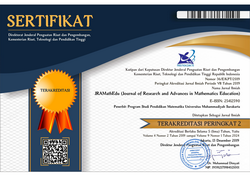Chess, visual memory and geometric transformations
Jorge Jhonattan Castellanos Sosa(1*), Francy Karina Maldonado Aguilar(2)(1) Huelva University, Spain
(2) National Pedagogic University, Colombia
(*) Corresponding Author
Abstract
Keywords
Full Text:
PDFReferences
Alloway, T.P., Gathercole, S. E. & Pickering, S. J. (2006). Verbal and visuospatial short-term and working memory in children: are they separable? Child Development, 77(6), 1698-1716. https://doi.org/10.1111/j.1467-8624.2006.00968.x
Benton, A. (1974). Revised Visual Retention Test. Clinical and Experimental Applications 4th edition, Psychological Corporation. New York.
Blanco, J. (2020). El ajedrez como herramienta pedagógica: contextualización y fundamentación de los elementos psicopedagógicos. Capablanca, 1(2), 14-30
Brady, T. F., Konkle, T., Alvarez, G. A. & Oliva, A. (2008). Visual long-term memory has a massive storage capacity for object details. Proceedings of the National Academy of Sciences, 105(38), 14325-14329. https://doi.org/10.1073/pnas.0803390105
Chase, W. G. & Simon, H. A. (1973). The mind's eye in chess. In Visual Information Processing (pp. 215-281). Academic press.
Chi, M., Glaser, R., & Rees, E. & Steinberg, R. J. (1982). Advances in the psychology of human intelligence. Expertise in problem solving. In R. Sternberg (Ed.) (pp. 7–75).
Cohen, L., Manion, L. & Morrison, K. (2017). Research methods in education (pp. 440-456). Routledge.
Ericsson, K. A., Patel, V., & Kintsch, W. (2000). How experts' adaptations to representative task demands account for the expertise effect in memory recall: Comment on Vicente and Wang (1998). Psychological Review, 107(3), 578–592. https://doi.org/10.1037/0033-295X.107.3.578
Ericsson, K. A. & Polson, P. G. (1988). An experimental analysis of the mechanisms of a memory skill. Journal of Experimental Psychology: Learning, Memory, and Cognition, 14(2), 305–316. https://doi.org/10.1037/0278-7393.14.2.305
Ferguson, R. (1995). Resumen sobre Investigaciones del Ajedrez y su Impacto en la educación. Director Ejecutivo American Chess School. Fundación Rotaria de Panamá.
Fernández, J. (2006). Memory and perception: Remembering snowflake. THEORIA. Revista de teoría, historia y fundamentos de la ciencia, 21(2), 147-164. https://doi.org/10.1387/theoria.534
Ferreira, D. & Palhares, P. (2008). Chess and problem solving involving patterns. The Mathematics Enthusiast, 5(2), 249-256.
Fukuda, K. & Vogel, E. K. (2019). Visual short-term memory capacity predicts the “bandwidth” of visual long-term memory encoding. Memory & cognition, 47(8), 1481-1497. https://doi.org/10.3758/s13421-019-00954-0
Ganguly, D., Leveling, J. & Jones, G. J. (2014, July). Retrieval of similar chess positions. In Proceedings of the 37th international ACM SIGIR conference on Research & development in information retrieval (pp. 687-696). https://doi.org/10.1145/2600428.2609605
Giofrè, D., Mammarella, I. C., Ronconi, L. & Cornoldi, C. (2013). Visuospatial working memory in intuitive geometry, and in academic achievement in geometry. Learning and Individual Differences, 23, 114-122. https://doi.org/10.1016/j.lindif.2012.09.012
Gong, Y., Ericsson, K. A., & Moxley, J. H. (2015). Recall of briefly presented chess positions and its relation to chess skill. PLoS One, 10(3). https://doi.org/10.1371/journal.pone.0118756
Jaime Pastor, A. (1993). Aportaciones a la interpretación y aplicación del modelo de Van Hiele: la enseñanza de las isometrías del plano. la evaluación del nivel de razonamiento (Order No. U607169). Available from ProQuest Dissertations & Theses Global (1525360907).
Jeffers-Duarte, B., Osorio-Curbelo, F. & Guevara-Torres, M. (2020). Capacidades Físicas que deberían desarrollar los ajedrecistas en el alto rendimiento. Capablanca, 1(1), 55-70. Retreived from http://200.14.55.139/index.php/Ajedrez/article/view/7
Kadunz, G. & Yerushalmy, M. (2015). Visualization in the Teaching and Learning of Mathematics. In The Proceedings of the 12th International Congress on Mathematical Education (pp. 463-467). Springer, Cham. https://doi.org/10.1007/978-3-319-12688-3_41
Kaiser, G. (2017). Proceedings of the 13th International Congress on Mathematical Education: ICME-13. Springer Nature.
Kant, I. (2007). Anthropology from a Pragmatic Point of View (1798). In R. B. Louden (Ed. and trans.), Anthropology History and Education (pp. 227-429). Cambridge: Cambridge University Press.
Manna C.B.G., Filangieri C.M., Borod J.C., Alterescu K. & Allison Bender H. (2018). Benton Visual Retention Test. In: Kreutzer J.S., DeLuca J., Caplan B. (eds) Encyclopedia of Clinical Neuropsychology. Springer, Cham. https://doi.org/10.1007/978-3-319-57111-9_1110
Marmolejo Avenia, G. A. & Vega Restrepo, M. B. (2012). La visualización en las figuras geométricas: Importancia y complejidad de su aprendizaje. Educación matemática, 24(3), 7-32.
Owens, K. (2015). Visuospatial reasoning: An ecocultural perspective for space, geometry and measurement education. New York: Springer.
Paas, F. & Ayres, P. (2014). Cognitive load theory: A broader view on the role of memory in learning and education. Educational Psychology Review, 26(2), 191-195. https://doi.org/10.1007/s10648-014-9263-5
Pacheco Acosta, H. L. (2020). Kant on Empirical and transcendental functions of memory. eidos, (32), 103-134. https://doi.org/10.14482/eidos.32.193
Pawilen, G. T. & Manuel, S. J. (2018). A Proposed Model and Framework for Developing a Curriculum for the Gifted in the Philippines. International Journal of Curriculum and Instruction, 10(2), 118-141.
Pirie, S., & Kieren, T. (1994). Growth in mathematical understanding: How can we characterize it and how can we represent it?. In Learning Mathematics (pp. 61-86). https://doi.org/10.1007/BF01273662
Schneider, W. & Shiffrin, R. M. (1977). Controlled and automatic human information processing: I. Detection, search, and attention. Psychological review, 84(1), 1. https://doi.org/10.1037/0033-295X.84.1.1
Sinclair, N., Bussi, M. G. B., de Villiers, M., Jones, K., Kortenkamp, U., Leung, A. & Owens, K. (2017). Geometry education, including the use of new technologies: A survey of recent research. In Proceedings of the 13th international Congress on Mathematical Education (pp. 277-287). Springer, Cham. https://doi.org/10.1007/978-3-319-62597-3_18
Sivan, A. B. (1992). Benton Visual Retention Test (5th ed.). Psychological Corporation. San Antonio.
Snow, J. H. (1998). Clinical use of the Benton Visual Retention Test for children and adolescents with learning disabilities. Archives of Clinical Neuropsychology, 13(7), 629-636. https://doi.org/10.1016/S0887-6177(97)00098-X
Standing, L. (1973). Learning 10000 pictures. The Quarterly journal of experimental psychology, 25(2), 207-222. https://doi.org/10.1080/14640747308400340
Steck, P. H. (2005). A revision of AL Benton's Visual Retention Test (BVRT) in two parallel forms. Archives of clinical Neuropsychology, 20(3), 409-416. https://doi.org/10.1016/j.acn.2004.09.009
Subia, G. S. (2020). Treasure Chess: Worthy Contributions of the Game in the Lives of Student Champions. The Normal Lights, 14(1).
Taymur, M. & Vázquez, I. (1998). El Ajedrez Educativo Como Materia Formativa Esencial en edad Escolar. España: Comunicación presentada en el congreso de Madrid.
Van Hiele, P. M. (1986): Structure and insight. A theory of mathematics education. (Academic Press: Londres).
Article Metrics
Abstract view(s): 879 time(s)PDF: 643 time(s)
Refbacks
- There are currently no refbacks.








